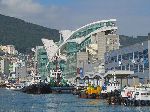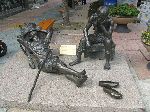Ibike Korea People-to-People Program
 Photo essay: Busan
Walking Tour
Photo essay: Busan
Walking Tour
Walking tour: Sample the
sights of this modern South Korean city.
Points of Interest: Gwangbok-ro, Jagalchi Mrkt, Gukje Mrkt, 40 steps, Yongdusan
Park & more.
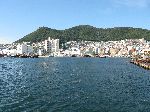

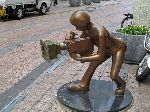
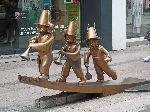 This walk starts at PIFF Square, named in honor of the Busan
International Film Festival, which started in 1996 and has been getting bigger
every year, since. There are a variety of architectural and art features in the
area that celebrate the film festival.
This walk starts at PIFF Square, named in honor of the Busan
International Film Festival, which started in 1996 and has been getting bigger
every year, since. There are a variety of architectural and art features in the
area that celebrate the film festival.
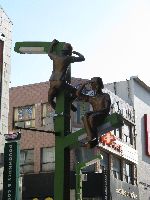
 From
there we turn the corner and walk down Gwangbok-ro (Independence Rd), originally
a stream, by 1895 it was so polluted that it was covered. During the Korean War
many artists relocated to Busan in fear of the communists oppression. A lot of
artists settled in Gwangbok-dong, Nampo-dong and Donggwang-dong and continued
their production despite economic hardship. These neighborhood emerged as a hub
of cultural activities and continued to play that role for several decades until
the area was gentrified into "Fashion Street" around the turn of the century.
One focal point of Gwangbok-ro is City Spot, which has a sculpture of people and
birds, and an exhibit of dedications to Busan from its sister-cities around the
world. There are a half-dozen other interesting sculptures along the
street, including a couple boys who have climbed a light pole.
From
there we turn the corner and walk down Gwangbok-ro (Independence Rd), originally
a stream, by 1895 it was so polluted that it was covered. During the Korean War
many artists relocated to Busan in fear of the communists oppression. A lot of
artists settled in Gwangbok-dong, Nampo-dong and Donggwang-dong and continued
their production despite economic hardship. These neighborhood emerged as a hub
of cultural activities and continued to play that role for several decades until
the area was gentrified into "Fashion Street" around the turn of the century.
One focal point of Gwangbok-ro is City Spot, which has a sculpture of people and
birds, and an exhibit of dedications to Busan from its sister-cities around the
world. There are a half-dozen other interesting sculptures along the
street, including a couple boys who have climbed a light pole.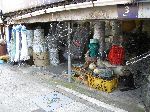
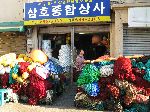 Continuing
on you get to the Rope, Nets and Floats Market. Who knew that there were so many
kinds, colors and sizes or rope, net, traps and floats. I suppose the
fisherman take it for granted.
Continuing
on you get to the Rope, Nets and Floats Market. Who knew that there were so many
kinds, colors and sizes or rope, net, traps and floats. I suppose the
fisherman take it for granted.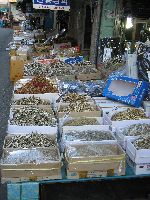
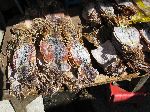
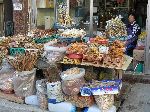
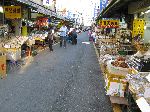
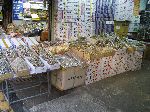
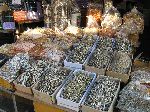
Around
the corner the dominant merchandise changes to dried fish. Who knew that there

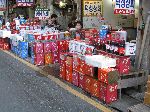 were so many colors, sizes and
varieties
dried fish.. It turns out that sea weed, fish sauce and mushrooms are also part of
this category. We such a variety of dried fish it is had to do the market
justice with so few pictures.
were so many colors, sizes and
varieties
dried fish.. It turns out that sea weed, fish sauce and mushrooms are also part of
this category. We such a variety of dried fish it is had to do the market
justice with so few pictures.
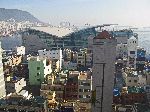
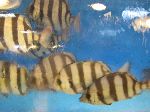
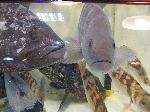
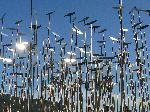

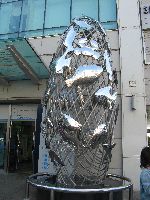
 The
dried fish market transitions into the live fish Jagalchi Market. The building is distinctive because of its is seagull-winged shape roof. Both in the
front and the back of the building there are art pieces with fish as the central
theme. Inside there are thousands of tanks and dishes with water flowing
everywhere and the fish watching the people go by. Jagalchi Market started
in the 1950's, during the war, as a market for black market goods.
The
dried fish market transitions into the live fish Jagalchi Market. The building is distinctive because of its is seagull-winged shape roof. Both in the
front and the back of the building there are art pieces with fish as the central
theme. Inside there are thousands of tanks and dishes with water flowing
everywhere and the fish watching the people go by. Jagalchi Market started
in the 1950's, during the war, as a market for black market goods.
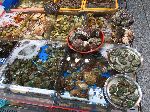
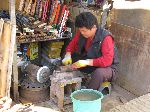

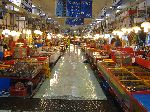 Fish mongers need good sharp knives
so the fish market had several knife sharpeners (right) spread around.
Fish mongers need good sharp knives
so the fish market had several knife sharpeners (right) spread around.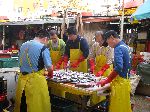

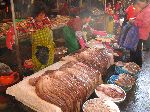
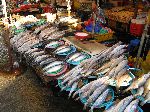 Back
outside, there are not as many tanks of live fish, but there is a wide variety
of fresh fish (snappers, mackerel, octopus, ell, rock fish, grouper, tuna,
clams, etc.)
Back
outside, there are not as many tanks of live fish, but there is a wide variety
of fresh fish (snappers, mackerel, octopus, ell, rock fish, grouper, tuna,
clams, etc.) 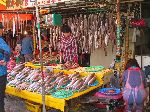

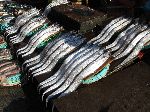
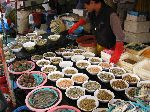
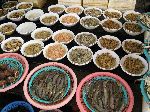
There are so many different kinds of fish with so many different sizes, shapes, colors, and textures, that you feel compelled to keep taking
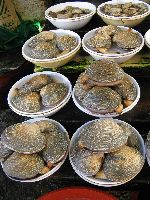

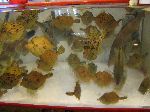


pictures so that you can do it justice, knowing that you will always be leaving something out.
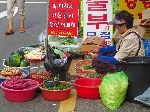
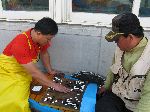
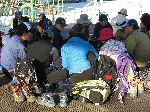
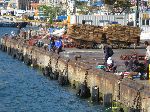
The market is not all work and no play; a fish monger stopped for a game of go, a group of walkers was relaxing on the pier sharing a picnic and along one of the wharfs a number of men were watching and waiting for their fishing poles to spring to life, indicating a fish on the end of the line.
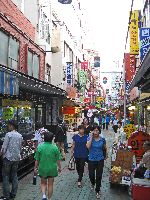
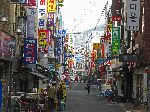 Enough of the fish for a while.
Away from the wharf the is fifty square blocks of retail, consisting of Bupyeong-dong
Market and Gukje Market.
Signs and banners on the sides of building advertise the diversity of
businesses. The signage can get to be quite hectic and by North America
standards would be considered visual pollutions. But for now, in Korea, it
is the character of the cityscape.
Enough of the fish for a while.
Away from the wharf the is fifty square blocks of retail, consisting of Bupyeong-dong
Market and Gukje Market.
Signs and banners on the sides of building advertise the diversity of
businesses. The signage can get to be quite hectic and by North America
standards would be considered visual pollutions. But for now, in Korea, it
is the character of the cityscape.
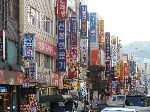 A major period of growth was the early
1950's when the influx of refugees increased both the number of street merchants
and consumers hunting for bargain-priced products and food. In the end of 1954,
a devastating fire dealt a blow to the burgeoning economy of the area, as it
engulfed the whole refugee area and left a number of people homeless. Gukje Market is still considered the place to go to find the best prices in
Busan.
A major period of growth was the early
1950's when the influx of refugees increased both the number of street merchants
and consumers hunting for bargain-priced products and food. In the end of 1954,
a devastating fire dealt a blow to the burgeoning economy of the area, as it
engulfed the whole refugee area and left a number of people homeless. Gukje Market is still considered the place to go to find the best prices in
Busan.
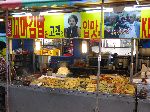
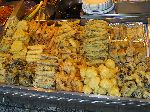
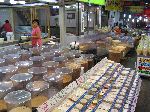
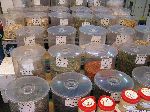

There was section of the market for snack food, a section for dried beans and grains, a section for fresh vegetable, a section for furniture, a section clothes, a section for cooking utensils, a section for shoes, a section for jewelry, a section for crafts, a section for hardware, and the list could go on.
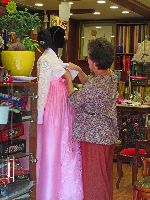
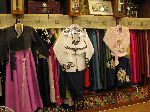

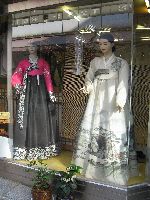 In
the
Hanbok district, custom hanboks are made in dozens of shops. There seem to
be so many styles and some colors and kinds of fabric that it is possible that no
two hanboks in the country need be alike. If you want one all you need to do is pick you
style and fabric -- probably not an easy task given so many choices. From the
look of the intensity of the decision making in the hanbok shops, great
consideration was being giver to every detail.
In
the
Hanbok district, custom hanboks are made in dozens of shops. There seem to
be so many styles and some colors and kinds of fabric that it is possible that no
two hanboks in the country need be alike. If you want one all you need to do is pick you
style and fabric -- probably not an easy task given so many choices. From the
look of the intensity of the decision making in the hanbok shops, great
consideration was being giver to every detail.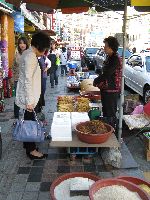
 Gukje
Market still has a variety of street merchants. This woman is selling
fresh ginseng. In the foreground (left) are some tubs of rice. Behind the
ginseng seller is a merchant with hair products and household goods, and other
vendors stretch down the block, on both sides of the street.
Gukje
Market still has a variety of street merchants. This woman is selling
fresh ginseng. In the foreground (left) are some tubs of rice. Behind the
ginseng seller is a merchant with hair products and household goods, and other
vendors stretch down the block, on both sides of the street.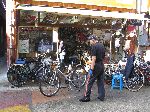
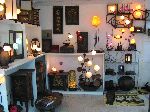 I
would be remise if I did mention the bike shop in the Gukje area. Even more
fascinating is the Gukje Underground Market, which is full of venders and runs
for several hundred meters under the road. That is where you will have to
go to find the high-end, home decorating boutique (right).
I
would be remise if I did mention the bike shop in the Gukje area. Even more
fascinating is the Gukje Underground Market, which is full of venders and runs
for several hundred meters under the road. That is where you will have to
go to find the high-end, home decorating boutique (right).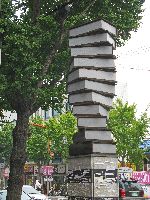

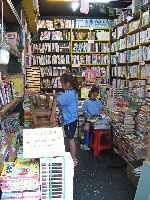
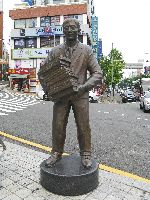
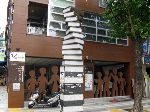
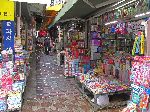
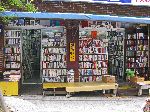
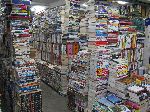
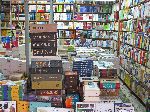

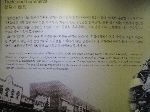
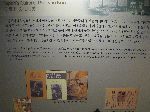
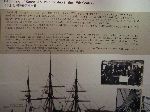
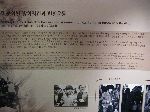
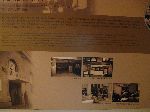
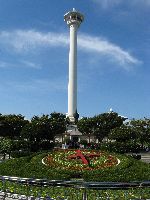
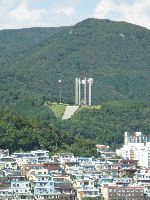 Yongdusan
Park was established to remember the refugees who once called the area home, the
war that devastated their lives and the 1954 fire that swept through Gukje
market and dealt their burgeoning economy a sever blow.
Yongdusan
Park was established to remember the refugees who once called the area home, the
war that devastated their lives and the 1954 fire that swept through Gukje
market and dealt their burgeoning economy a sever blow.The park is now dominated by 300m Busan Tower, which gives a clear view of Democracy Park on the peak to the north.
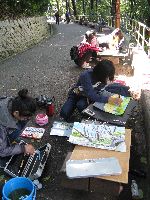
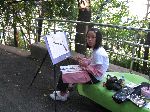

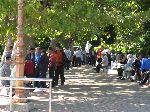
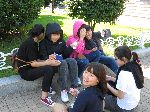
Even on a weekday afternoon the park was full of people; there was an art class of young girls scattered around, groups of older men sat and pass the time together, and some teenager girls were probably do the Korean equivalent of hanging out.
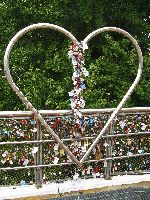
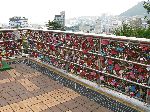
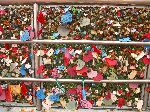 The Love-Lock Heart is a very sweet and
romantic installation: Couples attach there names to a padlock and then
lock it to the heart or the fence behind it. There are a hundred feet of
fence with
thousands of locks hanging from it. Only a cynic would ponder whether the
couple come back and cuts the lock off as a ritual if they break-up. [There is a
similar fence at Namsan Tower in Seoul.]
The Love-Lock Heart is a very sweet and
romantic installation: Couples attach there names to a padlock and then
lock it to the heart or the fence behind it. There are a hundred feet of
fence with
thousands of locks hanging from it. Only a cynic would ponder whether the
couple come back and cuts the lock off as a ritual if they break-up. [There is a
similar fence at Namsan Tower in Seoul.]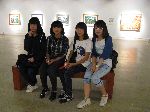 We met this group of girls in an
art exhibit. The exhibit wasn't drawing a lot of attention during our
visit, but it was a gorgeous day outside.
We met this group of girls in an
art exhibit. The exhibit wasn't drawing a lot of attention during our
visit, but it was a gorgeous day outside.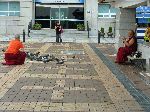
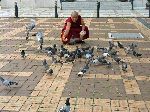
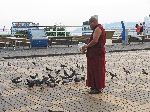 On
another occasion we met a couple monks who spent more than a half hour feeding
the birds. I don't know if it was a one-time event or a frequent ritual,
but they took some pictures of their activities themselves (left).
On
another occasion we met a couple monks who spent more than a half hour feeding
the birds. I don't know if it was a one-time event or a frequent ritual,
but they took some pictures of their activities themselves (left).
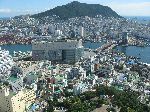
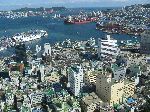

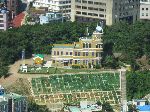
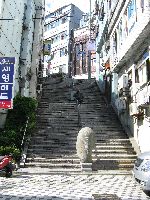

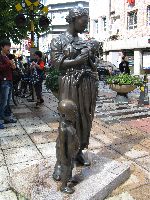
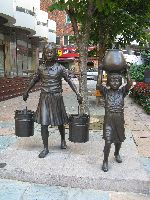
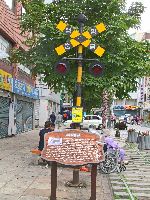
 Generally the Korean War created a lot of refugees
across the country. Specifically, because Busan had been spared any fighting, it
was a heaven and several million refugees headed there. One area that they settled,
with makeshift and substandard houses, from hill to hills, were the slopes
above "40 Steps" (40 Gyedan). 40 Steps was the way down to the city to find
food and try to make a little money for survival. 40 Steps Cultural Streets is
now remembers the struggles and good times of
the refugees who lived in the area.
The art includes (Railway Rd) The Gate of Peace, Korean popcorn vender, train
tracks, Mother and Children, Children carrying water, Railroad Crossing Square and (Coastal Rd)
Relaxation of a Father, Wharf Square and Sora Gyedan (spiral stairs).
Generally the Korean War created a lot of refugees
across the country. Specifically, because Busan had been spared any fighting, it
was a heaven and several million refugees headed there. One area that they settled,
with makeshift and substandard houses, from hill to hills, were the slopes
above "40 Steps" (40 Gyedan). 40 Steps was the way down to the city to find
food and try to make a little money for survival. 40 Steps Cultural Streets is
now remembers the struggles and good times of
the refugees who lived in the area.
The art includes (Railway Rd) The Gate of Peace, Korean popcorn vender, train
tracks, Mother and Children, Children carrying water, Railroad Crossing Square and (Coastal Rd)
Relaxation of a Father, Wharf Square and Sora Gyedan (spiral stairs).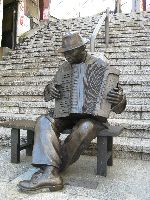
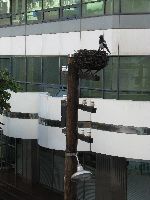
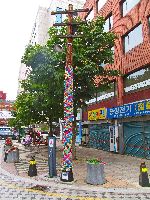
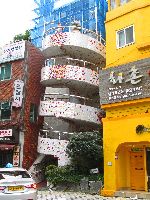

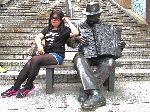
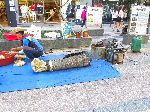 Occasionally, you can still find someone making popcorn in the traditional way.
Occasionally, you can still find someone making popcorn in the traditional way.
Korean artist are great about creating interactive art, and Koreans are great about interacting with them.
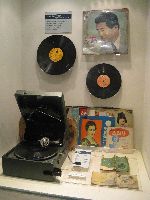
The 40 Steps Cultural Center is part of the neighborhood nostalgia. On 5th floor of the Service Center building is an exhibit show history of Jung-gu from before 1876, during Japanese colonial rule, the period of the Korean war, and the life of refugees in the 1950's. The 6th floor exhibit shows the history of Waegwan from the 1407 to 1876, Nampo-dong Theatrical District and more.
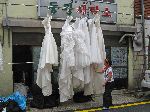
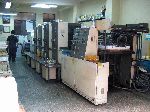 40
Gyedan is still a working neighborhood. The most common business is print
shops (right). There were a half-dozen shops with presses whirling away on
one block. That makes it the print-shop district.
40
Gyedan is still a working neighborhood. The most common business is print
shops (right). There were a half-dozen shops with presses whirling away on
one block. That makes it the print-shop district.The most interesting undertaking was the seamstress preparing wedding dresses (left). To get enough room the dress were hung from a rod outside and were twice the height of the average Korean.
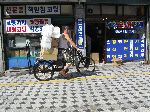
 Old
cities often have narrow street and Busan is no exception. Narrow streets
call for specialized vehicle to make deliveries. The cargo bike (left) and
the cargo motorcycle (right) may not be glamorous, but the are practical.
Old
cities often have narrow street and Busan is no exception. Narrow streets
call for specialized vehicle to make deliveries. The cargo bike (left) and
the cargo motorcycle (right) may not be glamorous, but the are practical.
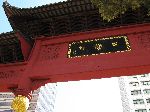 Chinatown
is at most four blocks (one block in each direction emanating from a central
intersection), but most of it is in the one block with the gate, two statues and
canopy. Beyond that there seems to be very little that is Chinese.
The characters on the gate are Rae-Rae-Kang-Ryung, which wish all people coming
and going through the gate good health and peace.
Chinatown
is at most four blocks (one block in each direction emanating from a central
intersection), but most of it is in the one block with the gate, two statues and
canopy. Beyond that there seems to be very little that is Chinese.
The characters on the gate are Rae-Rae-Kang-Ryung, which wish all people coming
and going through the gate good health and peace.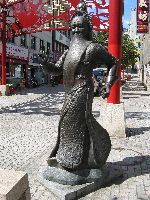

 Ba
wang and Bie Ji (left) are two characters from an old tradgic Beijing Opera. At the end
of the opera Ba wang is defeated in battle, Bie ji, his concubine commits
suicide and then Ba wang also kills himself as his only escape from misery.
Ba
wang and Bie Ji (left) are two characters from an old tradgic Beijing Opera. At the end
of the opera Ba wang is defeated in battle, Bie ji, his concubine commits
suicide and then Ba wang also kills himself as his only escape from misery.At the other end of the social spectrum, a mother carries a child on her back and a load on her head.
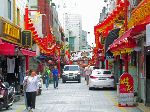
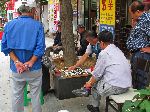 A
pastime in Chinatown seems to be to play and watch Go.
A
pastime in Chinatown seems to be to play and watch Go.Interestingly, the two very common scripts here, beside Hangul, are Cyrillic and Greek (for a small example, see the sign above the go players head.)
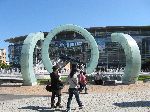
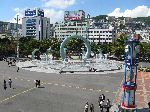
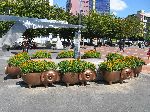

Busan Station is elegant with a welcoming plaza in front. Among its other features is a large sculpture/fountain, some pig-planters (I don't get the tie-in) and a sleek steel sculpture that emulate the bullet train(s).
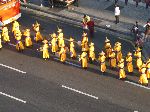
 While
we were back at the hotel to freshen up a small parade with traditionally
dressed musicians and a couple of lion dance teams passed by. The parade
was part of the opening of the Jagalchi Festival, an annual two-day
event, in October, that highlights the local fresh seafood industry. After the
opening ceremonies, which includes a parade of workers dressed like fish and
other sea animals, visitors can watch several events (boat launch ceremony, fish
dance exhibition, and fireworks), participate in contests (eel relay race,
foreigners' cooking contest, and Jagalchi ajuma pageant), listen to music
on several stages and, of course, eat fresh seafood, drink soju (rice
wine).
While
we were back at the hotel to freshen up a small parade with traditionally
dressed musicians and a couple of lion dance teams passed by. The parade
was part of the opening of the Jagalchi Festival, an annual two-day
event, in October, that highlights the local fresh seafood industry. After the
opening ceremonies, which includes a parade of workers dressed like fish and
other sea animals, visitors can watch several events (boat launch ceremony, fish
dance exhibition, and fireworks), participate in contests (eel relay race,
foreigners' cooking contest, and Jagalchi ajuma pageant), listen to music
on several stages and, of course, eat fresh seafood, drink soju (rice
wine).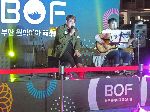
 Festival,
Busan Chinatown Special Zone Cultural Festival, and some other performances.
Festival,
Busan Chinatown Special Zone Cultural Festival, and some other performances.The stand on the right sells at least five varieties of "hasdogeu" (핫도그, hotdogs). This kind of take-away window seem to becoming increasing popular in Korea.
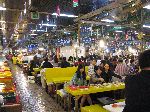
Let's checkout the Sindonga (Live) Fish market. Sindonga Fish Market is a vast hall filled with individual vendors with their own fish tanks and tables. It is very popular with the after work crowd who find raw fish and soju a pleasant combination.
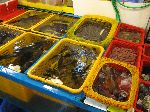
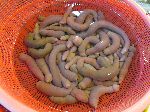
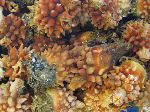
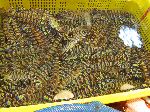
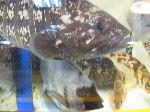
The menu is in the vats and tanks: (left to right) sea worms, squirts, octopus, shrimp, fish.

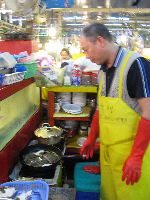
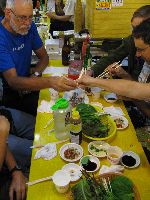 After you pick what
you want for your meal it is freshly prepared while you wait. The
operative word here is fresh. Most of the creatures are serve raw, but there is
an option to have some of the fish cooked. Looking around there wasn't a
lot of cooking going on. This is the raw fish market anyway.
After you pick what
you want for your meal it is freshly prepared while you wait. The
operative word here is fresh. Most of the creatures are serve raw, but there is
an option to have some of the fish cooked. Looking around there wasn't a
lot of cooking going on. This is the raw fish market anyway.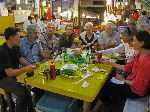

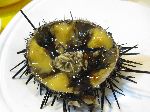 When the octopus lands
on the table it is still moving. After the little pieces of tentacle have
attached themselves to the plate they stop moving -- until you try to pry them
off to eat them, in which case they
wiggle frantically again -- even a half hour later. For sea urchin on the
half shell you only it the yellow custardy part. It in fact has a custardy
texture.
When the octopus lands
on the table it is still moving. After the little pieces of tentacle have
attached themselves to the plate they stop moving -- until you try to pry them
off to eat them, in which case they
wiggle frantically again -- even a half hour later. For sea urchin on the
half shell you only it the yellow custardy part. It in fact has a custardy
texture.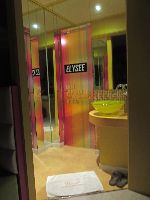
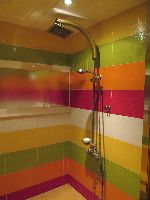 There
must be a thousand hotels in Busan. The high-end ones tend to have fewer
features (no in-room computer terminals, nothing in the mini-bar,
pay-as-go business centers, less toiletries, plainer bathrooms, etc) and
Western pegged price structures. Of coarse there are also the very
economical dives, but these are getting fewer and fewer. In the middle are
numerous hotels that are at the least spotless, bright, quiet, private and
very comfortable, and for the price, luxurious. The rooms with have both a
computer terminal and Wifi, the mini-bar will be stocked with a couple
complimentary juices and bottles of water, on the counter is coffee and
tea, the big screen TV has 100 channels of cable (but except for a couple
movie it may be that none are in English), and they are stocked with every
toiletry that male or female could possible need.
There
must be a thousand hotels in Busan. The high-end ones tend to have fewer
features (no in-room computer terminals, nothing in the mini-bar,
pay-as-go business centers, less toiletries, plainer bathrooms, etc) and
Western pegged price structures. Of coarse there are also the very
economical dives, but these are getting fewer and fewer. In the middle are
numerous hotels that are at the least spotless, bright, quiet, private and
very comfortable, and for the price, luxurious. The rooms with have both a
computer terminal and Wifi, the mini-bar will be stocked with a couple
complimentary juices and bottles of water, on the counter is coffee and
tea, the big screen TV has 100 channels of cable (but except for a couple
movie it may be that none are in English), and they are stocked with every
toiletry that male or female could possible need.
 Please
contact us if you would like to be added to
Ibike's mailing list or have questions, comments, corrections or criticism. (Also, please let us know how you learned about us and
found this site.) Privacy policy.
Please
contact us if you would like to be added to
Ibike's mailing list or have questions, comments, corrections or criticism. (Also, please let us know how you learned about us and
found this site.) Privacy policy.
![]() IBF Homepage
IBF Homepage ![]() Ibike Programs
Ibike Programs
![]() Ibike Schedule
Ibike Schedule
![]() Search
Search
